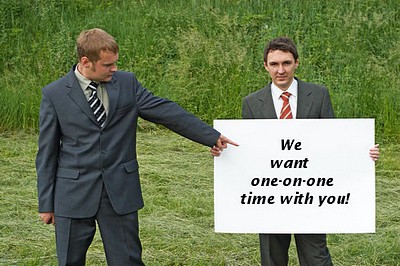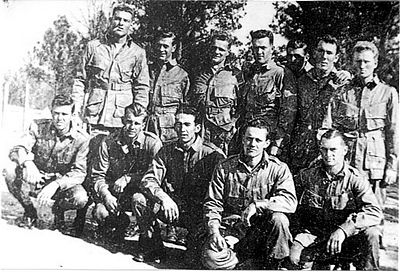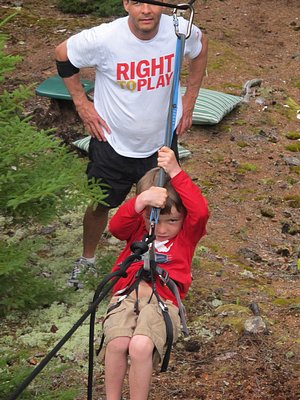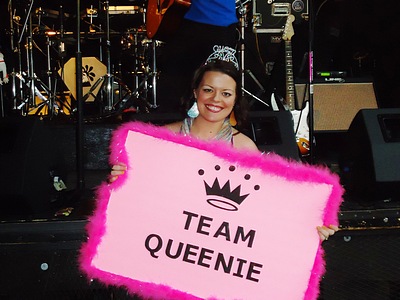ChangeAbility:
Leading Better with One-on-One's/Does Your Family Business Suffer from "Presenteeism"?
The Newsletter of Redpoint Coaching
Volume 10, No. 7, August 2011
Welcome!
In this issue's Leadership Insight column, Urs shares his thoughts on why one-on-one meetings are so important (and how you can run effective ones). Lauren's Family Business Insight focuses on "presenteeism" and how to address it in your family business.
As always, we love to hear from you. If you have question, comments or just want to tell us how you were inspired by a great book you read this summer, you can reach us at changeability@redpointcoaching.com.
Best Regards,
Urs and Lauren
P.S. Be sure to join our Facebook page for on-going tips, tools and news.
To subscribe or unsubscribe, go to the bottom of this message.
-----------------------------------------------------------------------------------------
IN THIS ISSUE:
-
One-on-One Meetings: One of the Most Effective Leadership Tools
- Urs' Summer Reading on Leadership
- Present, Accounted for, But Not Productive: Does Your Family Business Suffer from Presenteeism?
-
Lauren and Urs' Personal Corner: The Most Fun I Had This Month Was...
-----------------------------------------------------------------------------------------
Want a friend or colleague to read ChangeAbility? Have them sign up
here
Thanks for your support!
++++ NO SPAM/PRIVACY STATEMENT ++++
We never sell or give away subscriber
info
-----------------------------------------------------------------------------------------
1. One-on-One Meetings: One of the Most Effective Leadership Tools
by Urs Koenig, PhD, MBA
 During his tenure as CIO of Swissair (the former Swiss Airline) my dad applied for the top job at the Swiss Disaster Relief Agency. During the interview, he was asked to define leadership. He responded with a one liner (and was expected to present a thesis and as a result didn't get the job...): "Being a leader means getting things done through your people."
During his tenure as CIO of Swissair (the former Swiss Airline) my dad applied for the top job at the Swiss Disaster Relief Agency. During the interview, he was asked to define leadership. He responded with a one liner (and was expected to present a thesis and as a result didn't get the job...): "Being a leader means getting things done through your people."
While I like his definition for its brevity, the question remains: how do you get stuff done through your people? You engage them, you inspire them, you listen to them, you set goals for them and you hold them accountable.
And what is one of the most effective and efficient ways to engage, inspire, listen, set goals and hold your people accountable?
You guessed it: Conducting regular and meaningful one-on-one meetings with your direct reports.
As with so many of the things we coach our clients on, conducting regular, productive and meaningful one-on-ones is a very simple concept but not always easy to pull off.
Why have yet another meeting and what if I don't have time?
If you are like 90 % of the managers out there, most of your interactions with your people occur in an ad hoc manner -- during team meetings (even if many of the people present don't need to be part of the conversation), in hurried emails and voicemails, in passing in the hallway, or when a big problem desperately needs attention.
While all of these often interrupted, incomplete and hurried interactions are one-on-ones, they are seldom the most effective ones. Often there is no logic to the timing of these conversations. In fact, they are usually random, incomplete, and often too late to head off a problem or solve it before it grows large.
Regular one-on-one meetings will get you ahead of this curve. Not only will your people prepare for the time they have your undivided attention, they will discuss issues they won't bring up in a group meeting or in impromptu discussions: their dissatisfaction with part of their current role, interpersonal challenges or other problems that could keep them from succeeding at work.
 If your direct report is falling short, the one-on-one setting enables you to communicate in no uncertain terms what changes you need to see happening. Following the principal of praising in public and criticizing in private, you can be firmer and sterner during a one-on-one than during a team meeting.
Think of the perfect one-on-one meeting as hybrid of an information gathering, planning, coaching and accountability meeting.
If your direct report is falling short, the one-on-one setting enables you to communicate in no uncertain terms what changes you need to see happening. Following the principal of praising in public and criticizing in private, you can be firmer and sterner during a one-on-one than during a team meeting.
Think of the perfect one-on-one meeting as hybrid of an information gathering, planning, coaching and accountability meeting.
Like any meaningful meeting, not having it will cost you an expensive multiple of the time you would have spent in the meeting. Having it will save you time and headaches in the long run.
There is one more important, not often talked about benefit to regular, meaningful on-on-ones. By sitting down with your direct reports and demonstrating true interest and concern not only for their productivity but also for their input, opinions and development, you build a more committed and engaged team which leads to all sorts of well documented soft benefits (e.g. increased job satisfaction) and hard benefits (e.g. lower turn-over, lower recruiting and training costs).
But how do I best do them?
Schedule 30 minute one-on-one meetings with each of your direct reports at least every other week, better every week. Make it a regular, re-occurring meeting. Don't use travel as an excuse not to have it; conduct a phone meeting instead.
Keep a file for each of your direct reports where you gather all the none-time sensitive questions and issues you need to discuss with them. So rather than interrupting your folks constantly whenever you think of something, drop it in the file for discussion during the one-on-one. Take notes of issues raised in the one-on-one and agreed upon courses of action.
Here is my suggestion for a standing agenda for your one on one meeting:
1. Update on action items/commitments from last time
2. What is going well?
3. What are the obstacles and how can I (the manager) help?
4. Action items going forward
Once a quarter, I recommend you go 'bigger' and cover the following:
1. Where are we going (the organization)?
2. Where are you going?
3. What are you and your part of the biz doing well? What are you proud of?
4. What are your suggestions for improvements for the future (for the organization, for your part of the biz, for yourself)?
5. How can I help?
6. What suggestions for improvement do you have for me?
Have the one-on-one meeting primarily driven by your direct report. Make this a coaching conversation by asking lots of questions and listening well. Provide guidance if it's needed but do not fall into the trap of filling the time with your own talk. If you are taking up more than 30 % of air time, you are talking too much.
2. Urs' Summer Reading on Leadership
by Urs Koenig, PhD, MBA
Band of Brothers, E Company, 506th Regiment, 101st Airborne, US Army from Normandy to Hitler's Eagles Nest by Stephen Ambrose
 As good a rifle company as any in the world, Easy Company kept getting the tough assignments - from parachuting into Normandy on D-Day to taking Hitler's Eagles Nest. In this real life account, which has turned into an HBO series by Tom Hanks and Steven Spielberg, Ambrose tells of the men of this brave unit who fought, went hungry, froze and died; a company that took 150% casualties and considered the Purple Heart a badge of office.
As good a rifle company as any in the world, Easy Company kept getting the tough assignments - from parachuting into Normandy on D-Day to taking Hitler's Eagles Nest. In this real life account, which has turned into an HBO series by Tom Hanks and Steven Spielberg, Ambrose tells of the men of this brave unit who fought, went hungry, froze and died; a company that took 150% casualties and considered the Purple Heart a badge of office.
Ever since primary school I have been fascinated with WWII documentaries. One of the many questions I have asked myself about leadership in extreme crisis situations such as war is: why do people fulfill the mission, even if the mission is sometimes inhumane, useless and terribly wrong?
The answer is: soldiers fulfill the mission because they do not want to let the guy next to them down. They don't do it for a principle, not for the flag, and certainly not for their country.
Ambrose puts this as well as anyone when writing about the experience of the men of Easy Company: "They thought the Army was boring, unfeeling and chicken, and they hated it. They found combat to be ugliness, destruction, and death, and hated it. Anything was better than the blood, the carnage, the grime, the filth, the impossible demands made on the body, anything, that is, except letting down their buddies."
They also found in combat the closest brotherhood they ever knew. They found selflessness. They found they could love the other guy in their foxhole more than themselves. They found in war men who loved life who would give their life for them."
3.Present, Accounted for, But Not Productive: Does Your Family Business Suffer From Presenteeism?
 You suffer from "presenteeism" in your family business if you have one or several staff members who are physically present at the job but whose productivity is limited due to physical, mental, or emotional afflictions. They may be employees who are toughing out illness or chronic afflictions. Or, they may be physically healthy but have a high desire to leave their job but don't. These employees tend to have lower commitment, be more dissatisfied with their jobs and reduce morale on their team. In effect, they've "retired on the job."
You suffer from "presenteeism" in your family business if you have one or several staff members who are physically present at the job but whose productivity is limited due to physical, mental, or emotional afflictions. They may be employees who are toughing out illness or chronic afflictions. Or, they may be physically healthy but have a high desire to leave their job but don't. These employees tend to have lower commitment, be more dissatisfied with their jobs and reduce morale on their team. In effect, they've "retired on the job."
Presenteeism is estimated to occur three times more often than absenteeism. (Health & Wellness Research Database, 2005)
In our work with family businesses, we've seen both managers and rank and file employees who suffer from presenteeism. Besides the impact on team morale, they cause work load issues for those who work with them. By far the worst impact, however, is when it's either the founder or next generation member who suffers from presenteeism.
Maybe it's a founder who lost his passion for the work 10 years prior but never retired because he couldn't think of something better to do. Maybe it's a son or daughter (or cousin or aunt) who was never suited for their job, never wanted it, but felt pressured by other family members to join the company and ended up staying. Or maybe it's the sibling who didn't get picked as the next leader, stayed with the company, but has harbored resentments and ill-will resulting in poor (or no) performance on the job.
The impact of a presentee owner or successor on a family-owned company can be devastating. Opportunities are lost, key employees leave, and potential suitable successors walk away in frustration. The value of the business (typically more than 90% of a family's networth) spirals downward.
Presenteeism often is THE huge "elephant in the room" (issues that everyone knows about but no one wants to talk about) for many family businesses.
As with any other elephant in the room, the best way to deal with it is to 1) bring it out into the open and 2) put structures in place to prevent it from happening in the future. Easier said than done we know (especially when you have a founder who is suffering from "presenteeism"), but here are some steps to consider:
- Does your company have a culture of continuous improvement and open and constructive feedback, for all employees, including the owners?
- Are there formal evaluations and informal one-on-ones for employees, including family members?
- Does your ownership report to an outside board and is that board composed of members who can and will hold the owners accountable for their performance (or lack thereof)?
- Is there a policy in place for hiring family members that includes written job descriptions, interviews, and evaluation for job fit before they are brought into the company?
- If there is an existing family member not performing up to expectations, what's the plan for addressing the issue? What needs to happen for this "elephant" to be dealt with?
4. Lauren and Urs' Personal Corner: The Most Fun I Had This Month Was...
This column is our effort to celebrate the simple joys of having fun. Remember fun? You know, “lively, joyous play or playfulness: amusement, sport, recreation, etc.?"
Urs - The most fun I had this month was...
 Building a zip line with my kids in the woods of the family cabin on Squirrel Island, Maine. It brought back memories of my own childhood: family outings in the mountains with our dad where we did the same, boy scouts days and then rock climbing in my teenage years.
Building a zip line with my kids in the woods of the family cabin on Squirrel Island, Maine. It brought back memories of my own childhood: family outings in the mountains with our dad where we did the same, boy scouts days and then rock climbing in my teenage years.
Seeing Luc and Liam's faces of anticipation as I harnessed them in and clipped them on with the carabineer and then listing to their shrikes of joy as we lowered them was priceless. Next stop: Rappelling!
Lauren - The most fun I’ve had this month was...
 Serving as captain for Team Queenie in the annual SummeRun for the Marsha Rivkin Ovarian Cancer Research Center, based in Seattle, Washington. Although the goal of the event is to raise funds to fight a deadly disease, it is certainly a joyous day. Yes, there are tears, but there are also many smiles and laughter, and cheering crowds - and much camaraderie as we look around and see that every other team has either lost a loved one or is fighting to save one.
Serving as captain for Team Queenie in the annual SummeRun for the Marsha Rivkin Ovarian Cancer Research Center, based in Seattle, Washington. Although the goal of the event is to raise funds to fight a deadly disease, it is certainly a joyous day. Yes, there are tears, but there are also many smiles and laughter, and cheering crowds - and much camaraderie as we look around and see that every other team has either lost a loved one or is fighting to save one.
Our team was formed in honor of Rachel Thomas, a dear family friend who died in November 2009 at the age of 27. Queenie was her family nickname. The day also gives all of us who loved Rachel an opportunity to share stories and memories of a wonderful young woman.
+++++LET
US KNOW WHAT YOU THINK+++++
Send an email to ChangeAbility@redpointcoaching.com.
We welcome your feedback!
ChangeAbility is a publication of Redpoint Succession and Leadership Coaching, which is run by Lauren Owen, MBA and Urs Koenig PhD, MBA.
Visit Redpoint's website: www.redpointcoaching.com, or call: ++ 1 206 372 8626
Copyright Redpoint Succession and Leadership Coaching, 2011. All rights reserved
To subscribe to this newsletter (to receive it via email), please visit our subscription page
|
Sign up for our e-newsletter ChangeAbility. ChangeAbility brings you hands-on tips and cool resources for growing your business. |
